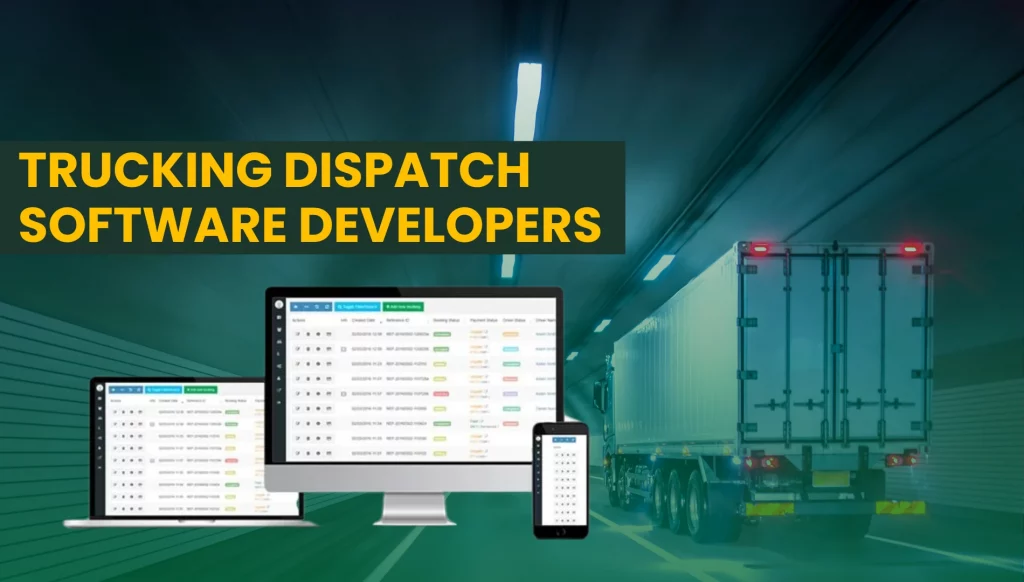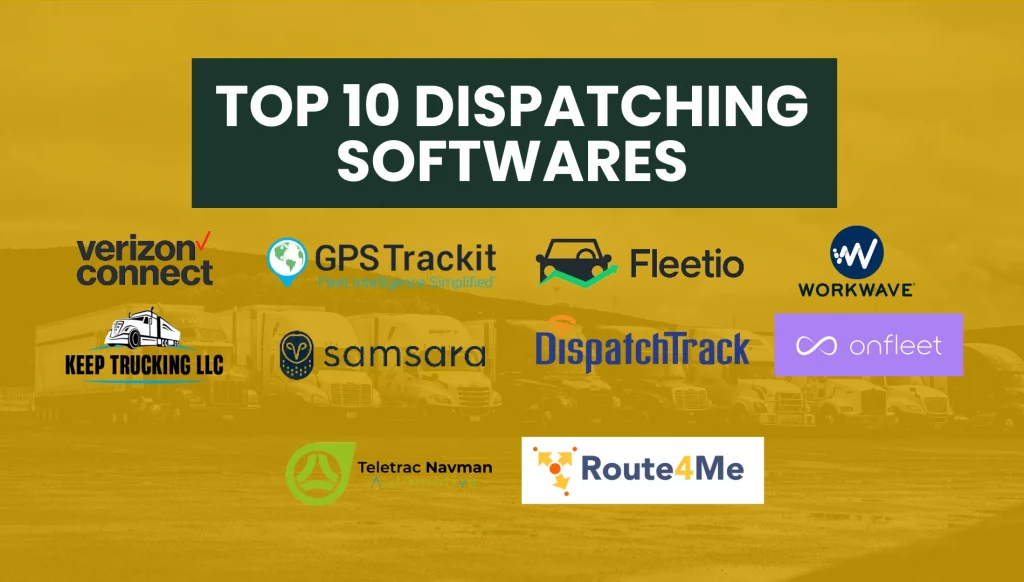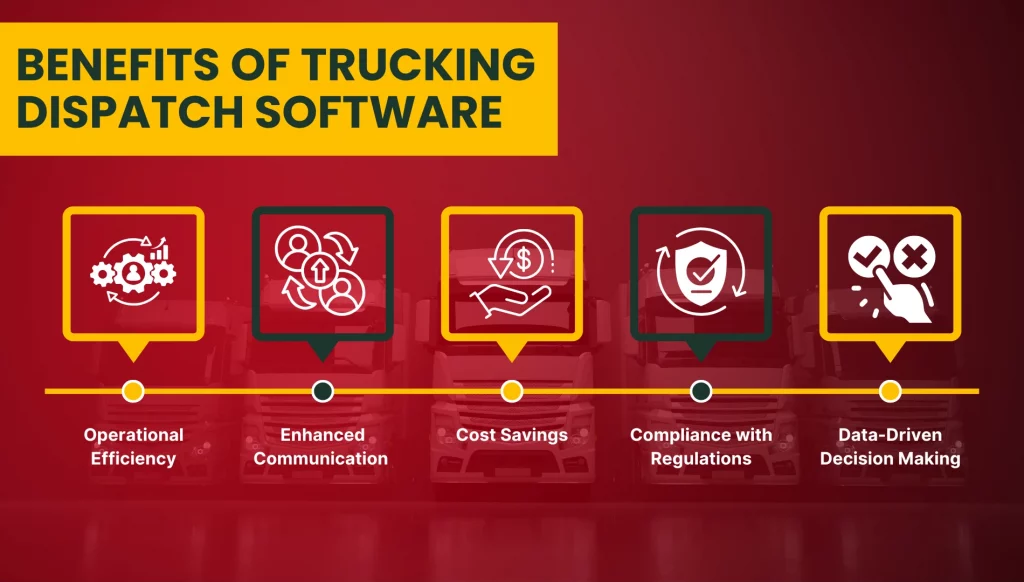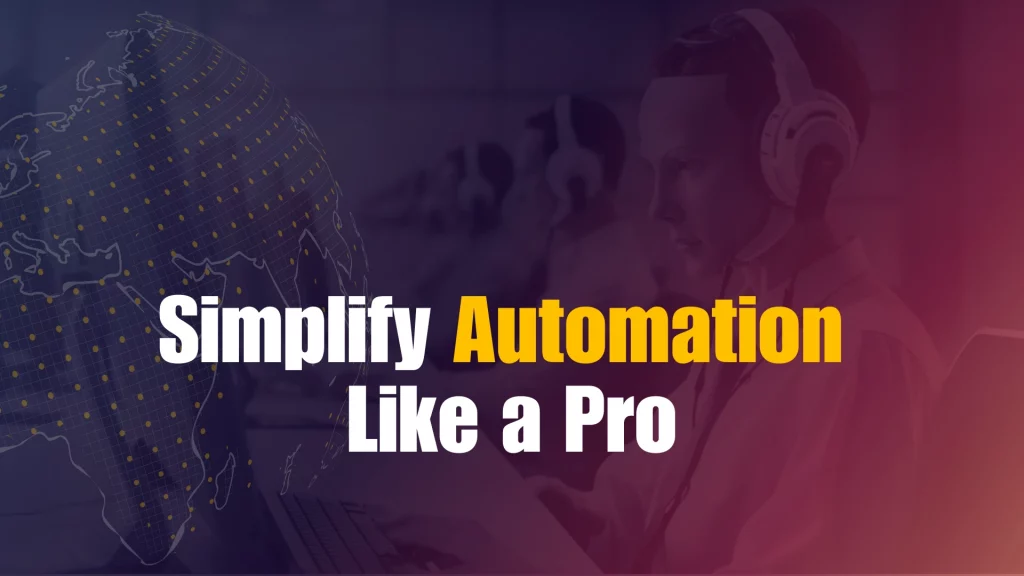Efficient fleet management is critical for success in the trucking industry, and the right trucking dispatch software can make all the difference. These tools empower businesses to streamline their operations, reduce costs, and enhance communication between drivers and dispatchers. In 2024, advancements in trucking software are bringing AI-driven optimization, real-time tracking, and mobile integration to the forefront.
Whether you’re managing a small fleet or a nationwide operation, dispatch software can improve efficiency and ensure compliance with industry regulations. By automating tasks like route planning, performance monitoring, and fuel tracking, these tools help businesses stay competitive in a fast-paced logistics landscape.

Table of Contents
Main Features of Trucking Dispatch Software
The success of any logistics operation depends on efficiency, and truck dispatching software plays a pivotal role. These tools streamline dispatching, reduce costs, and improve driver communication. In 2024, advanced software goes beyond basic scheduling to include AI-powered tools, real-time tracking, and seamless integrations. Understanding the essential features can help businesses make informed choices and maximize their return on investment.
1. Real-Time GPS Tracking
Trucking dispatch software provides live vehicle tracking to ensure timely deliveries. Dispatchers can monitor routes, track delays, and provide accurate ETAs to customers. This feature also helps reduce unauthorized vehicle usage.
2. Automated Route Optimization
AI-driven algorithms calculate the best delivery routes, minimizing travel distances and saving fuel. The software adapts to real-time changes, such as traffic or weather disruptions. This ensures that deliveries stay on schedule without manual intervention.
3. Driver Performance Monitoring
Advanced tools record metrics like speed, idle time, and on-time deliveries. These insights help improve driver efficiency and safety. Monitoring performance also identifies areas for training or improvement.
4. Integration with ELDs and Accounting Systems
Seamless integration with Electronic Logging Devices ensures compliance with Hours of Service regulations. Accounting tools simplify invoice management and expense tracking. This combination reduces administrative workload.
5. Customizable Reporting and Analytics
Analytics features allow businesses to assess fleet performance through detailed reports. Metrics like fuel efficiency, maintenance schedules, and delivery times inform better decision-making. Custom reports can be tailored to specific operational needs.
These features make modern dispatch software indispensable for trucking businesses aiming to stay competitive in 2024.
Criteria for Selection
Selecting the right trucking dispatch software can make a significant difference in operational efficiency and cost savings. With so many options available, it’s essential to evaluate software based on key criteria that align with your business needs. The right tool should not only simplify logistics but also adapt to your fleet’s size and future growth. By focusing on features, usability, and scalability, businesses can ensure a good return on their investment.
1. User-Friendliness and Ease of Onboarding
The software should have an intuitive interface that requires minimal training. A complex system can slow down adoption and frustrate users. Prioritize tools that offer streamlined onboarding and strong customer support.
2. Pricing and Scalability
It’s important to select software that fits within your budget but can grow with your fleet. Scalable pricing models, such as per-vehicle or per-user plans, allow businesses to expand without overpaying. Free trials can also help evaluate value for money.
3. Integration Capabilities
Modern dispatch software should integrate with existing systems like ELDs, accounting tools, and telematics. This ensures seamless operations without additional manual work. Compatibility with mobile apps is also essential for on-the-go updates.
4. Customer Support and Training
Reliable support is crucial for minimizing downtime during implementation or troubleshooting. Look for software providers offering 24/7 assistance and comprehensive training resources. These services enhance user experience and operational continuity.
5. Mobile Accessibility
With drivers often on the road, mobile compatibility is a must-have. Dispatch apps should allow real-time communication, status updates, and navigation assistance. This keeps both dispatchers and drivers informed and connected.
By focusing on these criteria, businesses can confidently choose software that enhances fleet performance and meets operational goals.
Top 10 Trucking Dispatch Software of 2024
Here’s a detailed look at the dispatching software for trucking, highlighting their features, unique advantages, and suitability for different business needs. These tools are transforming fleet management and logistics by providing real-time tracking, route optimization, and driver communication.

1. Verizon Connect
Verizon Connect is a fleet management software developed by Verizon, designed to optimize logistics and compliance for medium to large fleets. Known for its real-time tracking and robust compliance tools, Verizon Connect integrates seamlessly with Verizon’s telematics system, offering comprehensive fleet monitoring and performance tracking.
The platform provides businesses with an efficient solution for managing fleets, ensuring compliance, and optimizing routes to minimize costs. Its user-friendly interface and scalable features make it a reliable choice for enterprises looking to enhance fleet operations.
Key Features
- Real-Time GPS Tracking: Monitor vehicle locations and receive updates with geofencing.
- Route Optimization: Minimize fuel costs with AI-driven routing tools.
- Driver Scorecards: Evaluate and improve driver performance.
Pricing: Custom pricing based on fleet size and specific requirements.
Ideal User Base: Medium to large fleets.
Rare Points
- Verizon Connect is trusted by numerous medium to large fleets for its strong compliance features and robust performance monitoring capabilities.
- Its integration with Verizon’s telematics system ensures comprehensive fleet tracking and compliance.
Pros and Cons
| Pros | Cons |
| User-friendly interface | Premium pricing |
| Excellent support for compliance (ELDs and HoS). | Learning curve for new users. |
| Scalable for all fleet sizes |
2. Samsara
Samsara is an IoT-driven fleet management solution developed by Samsara Inc., designed to improve safety and optimize fleet operations. Known for its AI-powered route optimization and integration with IoT devices, Samsara provides businesses with real-time diagnostics and predictive maintenance capabilities.
The platform is ideal for large fleets looking to enhance operational efficiency and safety through advanced analytics and IoT integration. Its mobile-friendly design ensures access to fleet data on the go.
Key Features
- AI-Powered Route Optimization: Plan efficient routes to save time and fuel.
- Real-Time Driver Feedback: Improve safety and performance with live feedback.
- IoT Integration: Predictive maintenance with detailed vehicle diagnostics.
Pricing: Starts at $30 per vehicle per month.
Ideal User Base: Large fleets with IoT requirements.
Rare Points
- Samsara is trusted by large fleets worldwide for its strong IoT integration and advanced safety features.
- Samsara’s IoT integration enables predictive maintenance and real-time diagnostics.
Pros and Cons
| Pros | Cons |
| Strong analytics dashboard. | Expensive for smaller fleets. |
| Excellent scalability. | Requires a stable internet connection. |
| Mobile-friendly design for on-the-go access. |
3. GPS Trackit
GPS Trackit is an affordable fleet management software designed for small to mid-sized fleets. Known for its customizable alerts and strong reporting features, it simplifies tracking and maintenance scheduling for businesses seeking cost-effective solutions.
The platform is ideal for businesses looking to monitor driver behavior and vehicle health while keeping costs low. GPS Trackit offers free implementation support and customizable dashboards for tailored operations.
Key Features
- Fleet Tracking with Alerts: Set alerts for speed, idling, and route deviations.
- Driver Behavior Monitoring: Track and evaluate driver performance.
- Automated Maintenance Scheduling: Ensure timely maintenance with automated reminders.
Pricing: Starts at $23 per vehicle per month.
Ideal User Base: Small to mid-sized fleets.
Rare Points
- GPS Trackit is praised for its affordability and ease of use and serves a wide range of small and mid-sized fleets.
- Affordable pricing with strong reporting features tailored for small and mid-sized fleets.
Pros and Cons
| Pros | Cons |
| Cost-effective. | Limited advanced features for large fleets. |
| Customizable dashboards. | Basic UI design. |
| Free implementation support. |
4. KeepTruckin
KeepTruckin is a user-friendly fleet management software focused on compliance and driver management. Developed by KeepTruckin Inc., it excels in ELD integration and performance tracking, making it a top choice for small to medium fleets prioritizing safety and compliance.
The platform offers an intuitive mobile app and advanced analytics for fleet optimization, ensuring better driver management and fuel efficiency.
Key Features
- ELD Compliance: Seamless compliance with electronic logging device (ELD) mandates.
- Driver Coaching: Performance metrics to improve driver skills and safety.
- Fuel Optimization: Advanced analytics for cost-effective fuel usage.
Pricing: Starts at $20 per vehicle per month.
Ideal User Base: Small to medium fleets focused on compliance.
Rare Points
KeepTruckin is trusted by small to medium fleets for its strong focus on safety and compliance.
Its focus on driver management and safety sets it apart.
Pros and Cons
| Pros | Cons |
| Strong ELD integration. | Limited scalability for very large fleets. |
| Easy to use for small fleets. | Customer support can be slow. |
| Great mobile app. |
5. Fleetio
Fleetio is a fleet management platform developed by Fleetio, specializing in maintenance tracking and workflow automation. Known for its easy setup and strong mobile accessibility, Fleetio helps mid-sized fleets streamline their maintenance operations.
The platform emphasizes real-time collaboration and automated workflows, making it a preferred choice for businesses focused on keeping vehicles in top condition.
Key Features
- Maintenance Tracking: Comprehensive tools to monitor and schedule vehicle maintenance.
- Real-Time Collaboration: Seamless communication between drivers and dispatchers.
- Automated Workflows: Simplify fleet operations with automated task management.
Pricing: Starts at $5 per vehicle per month.
Ideal User Base: Mid-sized fleets needing maintenance tracking.
Rare Points
- Strong emphasis on maintenance and workflow automation.
- Mid-sized fleets widely use Fleetio for its robust maintenance and collaboration features.
Pros and Cons
| Pros | Cons |
| Easy setup and onboarding. | Higher cost for advanced features. |
| Strong mobile accessibility. | Limited support for route optimization. |
| Excellent maintenance features. |
6. DispatchTrack
DispatchTrack is a delivery management platform developed by DispatchTrack Inc., designed to optimize last-mile deliveries. Known for its dynamic scheduling and customer-centric tools, it helps businesses enhance delivery efficiency and customer satisfaction.
The platform is perfect for companies focused on last-mile logistics, offering real-time tracking and delivery analytics for streamlined operations.
Key Features
- Dynamic Scheduling: Adjust schedules in real-time for improved efficiency.
- Customer Notifications: Keep customers updated with real-time delivery notifications.
- Delivery Analytics: Analyze and improve delivery performance.
Pricing: Custom pricing based on fleet size and requirements.
Ideal User Base: Last-mile delivery companies.
Rare Points
- DispatchTrack serves delivery-centric businesses, praised for its scalability and customer focus.
- Best for last-mile delivery management.
Pros and Cons
| Pros | Cons |
| Strong focus on customer updates. | Expensive for small fleets. |
| Great for delivery-centric businesses. | Lacks advanced compliance features. |
| Scalable for various fleet sizes. |
7. WorkWave
WorkWave is a logistics software developed by WorkWave Inc., offering all-in-one solutions for fleet management. Known for its integration capabilities with CRM and accounting tools, WorkWave provides a seamless experience for businesses seeking to manage logistics efficiently.
The platform is ideal for mid to large fleets looking for an easy-to-use and integrated system for route planning and fleet tracking.
Key Features
- Route Optimization: Plan and optimize routes to save time and costs.
- Mobile App: Manage operations and updates on the go.
- CRM Integration: Seamlessly connect with customer management tools.
Pricing: Starts at $49 per vehicle per month.
Ideal User Base: Mid to large fleets.
Rare Points
- WorkWave is trusted by mid to large fleets for its strong integration capabilities and comprehensive feature set.
- Perfect for businesses seeking all-in-one logistics solutions.
Pros and Cons
| Pros | Cons |
| Excellent integrations. | Expensive for small fleets. |
| User-friendly interface. | Limited features for advanced analytics. |
| Good support options. |
8. Onfleet
Onfleet is a modern delivery management software developed by Onfleet, designed to streamline operations for delivery-focused businesses. With a clean and intuitive UI, Onfleet excels in route optimization and customer communication.
The platform offers robust analytics and API integrations, making it ideal for businesses of any size focused on delivery operations.
Key Features
- Route Optimization: Automatically find the most efficient routes.
- Customer Notifications: Send real-time updates with accurate ETAs.
- Advanced Analytics: Track delivery performance with detailed reports.
Pricing: Starts at $29 per vehicle per month.
Ideal User Base: Delivery-focused businesses of any size.
Notable Customers
- Onfleet is widely used by delivery-focused businesses for its ease of use and customer communication tools.
- Ideal for businesses focused on delivery operations.
Pros and Cons
| Pros | Cons |
| Clean and modern UI. | Lacks deep fleet maintenance tools. |
| Strong customer communication tools. | Higher pricing. |
| Easy API integrations. |
9. Teletrac Navman
Teletrac Navman is an advanced fleet management software developed by Teletrac Navman. Known for its strong compliance tools and analytics dashboard, it is ideal for medium to large fleets prioritizing regulatory adherence and driver behavior monitoring.
The platform is praised for its reliable ELD tools and AI-powered route recommendations, ensuring efficiency and compliance.
Key Features
- Fleet Tracking: Real-time tracking with driver scorecards.
- Compliance Tools: ELD and HoS compliance features.
- AI-Driven Routes: Optimize routes with intelligent recommendations.
Pricing: Custom pricing based on fleet needs.
Ideal User Base: Medium to large fleets focused on compliance.
Rare Points
- Teletrac Navman is trusted by medium to large fleets for its strong compliance and analytics tools.
- Strong compliance features and driver behavior monitoring
Pros and Cons
| Pros | Cons |
| Reliable ELD tools. | Steep learning curve. |
| Strong analytics dashboard. | Premium features cost extra. |
| Good customer support. |
10. Route4Me
Route4Me is a user-friendly route planning software developed by Route4Me Inc., designed to simplify logistics for small to mid-sized fleets. Known for its drag-and-drop functionality, it allows businesses to create and adjust routes with ease.
The platform offers flexible pricing and is perfect for businesses seeking a simple and efficient routing solution.
Key Features
- Route Optimization: Plan and adjust routes with drag-and-drop tools.
- Mobile App: Provide drivers with clear instructions in real time.
- Real-Time Adjustments: Quickly adapt to changes in delivery schedules.
Pricing: Starts at $19 per month.
Ideal User Base: Small to mid-sized fleets.
Rare Points
- Route4Me is a favorite among small to mid-sized fleets for its simplicity and affordability.
- Exceptional ease of use for route planning.
Pros and Cons
| Pros | Cons |
| Very easy to use. | Limited features for fleet tracking. |
| Flexible pricing plans. | Not ideal for compliance-focused operations. |
| Great for smaller fleets. |
Comparison Table of the Top 10 Trucking Dispatch Softwares
To help you make an informed decision, here’s a detailed comparison of the Top 10 Trucking Dispatch Softwares of 2024. This table summarizes their key features, pricing, and ideal user base for quick reference.
| Software | Key Features | Pricing | Ideal User Base | Unique Selling Point |
|---|---|---|---|---|
| Verizon Connect | Real-time tracking, geofencing, route optimization. | Custom pricing | Medium to large fleets | Integration with Verizon’s telematics system. |
| Samsara | AI route optimization, IoT diagnostics, driver feedback. | $30/vehicle/month | Large fleets with IoT needs | IoT integration for predictive maintenance. |
| GPS Trackit | Tracking, alerts, driver behavior monitoring, reporting. | $23/vehicle/month | Small to mid-sized fleets | Affordable with strong reporting features. |
| KeepTrucking | ELD compliance, performance metrics, fuel optimization. | $20/vehicle/month | Small to medium fleets | Driver management and safety focus. |
| Fleetio | Maintenance tracking, collaboration, automated workflows. | $5/vehicle/month | Mid-sized fleets needing maintenance | Strong emphasis on fleet maintenance. |
| DispatchTrack | Scheduling, delivery tracking, customer notifications. | Custom pricing | Last-mile delivery companies | Best for delivery-centric businesses. |
| WorkWave | Route optimization, mobile updates, CRM and accounting integration. | $49/vehicle/month | Mid to large fleets | All-in-one logistics solution with excellent integrations. |
| Onfleet | Route optimization, customer notifications, delivery analytics. | $29/vehicle/month | Delivery-focused businesses | Superior customer communication tools. |
| Teletrac Navman | Fleet tracking, ELD compliance, driver scorecards. | Custom pricing | Medium to large fleets | Strong compliance and behavior monitoring. |
| Route4Me | Route optimization, mobile app, drag-and-drop functionality. | $19/month | Small to mid-sized fleets | Very easy-to-use route planning features. |
Benefits of Using Trucking Dispatch Software
Investing in truck dispatching software is no longer optional for companies seeking to stay competitive in the logistics industry. These tools provide significant advantages that improve efficiency, enhance communication, and optimize costs. By automating repetitive tasks and offering actionable insights, dispatch software transforms the way fleets are managed, delivering benefits across the board.

1. Improved Operational Efficiency
Dispatch software automates time-consuming tasks like route planning and driver scheduling. It reduces manual errors and speeds up decision-making. This helps fleets operate more smoothly and reduces downtime.
2. Enhanced Communication
Real-time updates between dispatchers and drivers ensure clarity and reduce misunderstandings. Features like instant messaging and status updates keep all stakeholders informed. This improves customer satisfaction by providing accurate delivery updates.
3. Cost Savings
Optimized routes and reduced idle times help lower fuel costs significantly. The software also identifies inefficiencies in fleet operations, enabling cost-saving measures. Automated billing reduces administrative expenses.
4. Compliance with Regulations
Software integrated with ELDs ensures adherence to Hours of Service rules. Automated tracking simplifies audits and regulatory reporting. This reduces the risk of fines and penalties.
5. Data-Driven Decision Making
Analytics features provide actionable insights into fleet performance. Businesses can track KPIs like delivery times, fuel usage, and driver efficiency. These insights help in strategic planning and continuous improvement.
By offering these benefits, trucking dispatch software helps businesses enhance performance while reducing operational complexities.
Trends in Trucking Dispatch Software for 2024
The trucking dispatch software landscape is rapidly evolving, driven by technological advancements and industry demands. Understanding these trends will help businesses stay ahead in 2024. Many of these trends align with the capabilities offered by offshore AI development teams, making cutting-edge solutions more accessible.
1. AI and Automation
Advanced AI is being used to optimize routes, predict maintenance needs, and automate repetitive tasks. This reduces human error and boosts operational efficiency.
2. Cloud-Based Solutions
Cloud technology enables remote access to dispatch tools from anywhere. This trend supports greater flexibility for dispatchers and fleet managers, especially in hybrid work setups.
3. IoT and Telematics Integration
Integrating IoT devices for vehicle diagnostics and telematics systems provides real-time insights into fleet health. This improves decision-making and reduces downtime.
4. Sustainability-Focused Features
With growing emphasis on sustainability, software is incorporating tools to monitor and reduce fuel consumption. These features support eco-friendly operations.
5. Enhanced Mobile Accessibility
Mobile-first designs are becoming a priority to support drivers on the road. Features like real-time updates and driver notifications keep operations connected at all times.
Final Words
Managing a fleet efficiently in 2024 requires more than manual planning it demands cutting-edge tools tailored to meet evolving challenges. Trucking dispatch software is no longer a luxury but a necessity for businesses of all sizes. By investing in the right solution, you can optimize operations, reduce costs, and improve driver satisfaction.
Evaluate your fleet’s needs, from real-time tracking to route optimization, and explore the top solutions highlighted here. The right software will empower you to navigate logistics complexities with ease and stay competitive in the fast-paced trucking industry.
FAQs About Trucking Dispatch Software
1. What is trucking dispatch software?
Trucking dispatch software is a digital tool designed to optimize fleet management. It helps with tasks like route planning, real-time tracking, driver communication, and compliance with regulations. These tools improve efficiency and reduce operational costs.
2. How does trucking dispatch software benefit small fleets?
Small fleets can save time and money by automating dispatching and route optimization. These tools improve fuel efficiency and streamline communication, enabling even smaller operations to compete with larger companies.
3. Is trucking dispatch software suitable for large fleets?
Yes, large fleets benefit from advanced features like integration with ELDs, detailed analytics, and scalable route management. These tools help manage complex operations and improve overall fleet performance.
4. What are the costs associated with trucking dispatch software?
Pricing depends on features and fleet size. Some software offers per-vehicle pricing starting at $19/month, while others provide custom pricing for enterprise solutions. Free trials are often available for evaluation.
5. Can trucking dispatch software ensure regulatory compliance?
Yes, many solutions integrate with ELDs to track Hours of Service (HoS) and ensure compliance with federal regulations. They also provide automated reporting, simplifying audits and reducing penalties.






